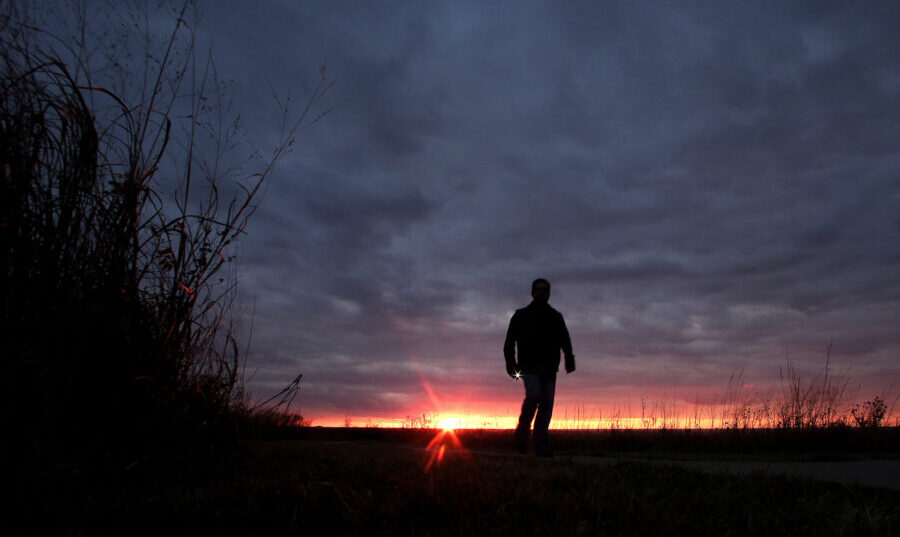US suicides hit an all-time high last year
Aug 10, 2023, 12:09 PM | Updated: 1:43 pm

FILE - In this Nov. 20, 2015 file photo, a man walks along a trail during sunset near Manhattan, Kan. In 2022, about 49,500 people took their own lives in the U.S., the highest number ever, according to data from the Centers for Disease Control and Prevention released on Thursday, Aug. 10, 2023. (AP Photo/Charlie Riedel, File)
Credit: ASSOCIATED PRESS
(AP Photo/Charlie Riedel, File)
NEW YORK (AP) — About 49,500 people took their own lives last year in the U.S., the highest number ever, according to new government data posted Thursday.
The Centers for Disease Control and Prevention, which posted the numbers, has not yet calculated a suicide rate for the year, but available data suggests suicides are more common in the U.S. than at any time since the dawn of World War II.
“There’s something wrong. The number should not be going up,” said Christina Wilbur, a 45-year-old Florida woman whose son shot himself to death last year.
Check in on your friends and loved ones.
If they’re showing emotional distress or signs of suicide, learn how you can #BeThe1To support them: https://t.co/BDz0lnbb2K pic.twitter.com/ehzkBDeFK4— SAMHSA (@samhsagov) August 10, 2023
“My son should not have died,” she said. “I know it’s complicated, I really do. But we have to be able to do something. Something that we’re not doing. Because whatever we’re doing right now is not helping.”
Experts caution that suicide is complicated, and that recent increases might be driven by a range of factors, including higher rates of depression and limited availability of mental health services.
Si estás pasando por un momento difícil con tu #saludmental, el 988, la Línea de Prevención del Suicidio y Crisis está disponible las 24 horas del día, todos los días del año. ¡Y los servicios de mensajes de texto y chat ya están disponibles en español! pic.twitter.com/INQXhNnCRu
— 988 Suicide & Crisis Lifeline (@988Lifeline) July 13, 2023
But a main driver is the growing availability of guns, said Jill Harkavy-Friedman, senior vice president of research at the American Foundation for Suicide Prevention.
Suicide attempts involving guns end in death far more often than those with other means, and gun sales have boomed — placing firearms in more and more homes.
A recent Johns Hopkins University analysis used preliminary 2022 data to calculate that the nation’s overall gun suicide rate rose last year to an all-time high. For the first time, the gun suicide rate among Black teens surpassed the rate among white teens, the researchers found.
Don’t forget to focus on self-care for your mental and physical health. Here are some ways to take care of yourself one small way each day. #WellnessWednesday pic.twitter.com/EhNWHU9C1P
— SAMHSA (@samhsagov) August 9, 2023
“I don’t know if you can talk about suicide without talking about firearms,” Harkavy-Friedman said.
U.S. suicides steadily rose from the early 2000s until 2018, when the national rate hit its highest level since 1941. That year saw about 48,300 suicide deaths — or 14.2 for every 100,000 Americans.
The rate fell slightly in 2019. It dropped again in 2020, during the first year of the COVID-19 pandemic. Some experts tied that to a phenomenon seen in the early stages of wars and natural disasters, when people pull together and support each other.
But in 2021, suicides rose 4%. Last year, according to the new data, the number jumped by more than 1,000, to 49,449 — about a 3% increase vs. the year before. The provisional data comes from U.S. death certificates and is considered almost complete, but it may change slightly as death information is reviewed in the months ahead.
The largest increases were seen in older adults. Deaths rose nearly 7% in people ages 45 to 64, and more than 8% in people 65 and older. White men, in particular, have very high rates, the CDC said.
Life might feel a little overwhelming lately, and that’s okay. If you ever feel like you need some extra emotional support, we’re here for you. Call or text the #988Lifeline. Caring crisis counselors are available 24/7/365. https://t.co/9V7lRPyNDD
— 988 Suicide & Crisis Lifeline (@988Lifeline) August 9, 2023
Many middle-aged and elderly people experience problems like losing a job or losing a spouse, and it’s important to reduce stigma and other obstacles to them getting assistance, said Dr. Debra Houry, the CDC’s chief medical officer.
Suicides in adults ages 25 to 44 grew about 1%. The new data indicates that suicide became the second leading cause of death in that age group in 2022, up from No. 4 in 2021.
Despite the grim statistics, some say there is reason for optimism. A national crisis line launched a year ago, meaning anyone in the U.S. can dial 988 to reach mental health specialists.
The CDC is expanding a suicide program to fund more prevention work in different communities. And there’s growing awareness of the issue and that it’s OK to ask for help, health officials say.
There was a more than 8% drop in suicides in people ages 10 to 24 in 2022. That may be due to increased attention to youth mental health issues and a push for schools and others to focus on the problem, CDC officials said.
But even the smaller number masks tragedy for families.
Christina Wilbur lost her 21-year-old son, Cale, on June 16 last year. He died in her home in Land O’ Lakes, Florida.
Cale Wilbur had lost two friends and an uncle to suicide and had been dealing with depression. On that horrible morning, he and his mother were having an argument. She had confronted him about his drug use, his mother said. She left his bedroom and when she returned he had a gun.
“I was begging him not too, and to calm down,” she said. “It looked like he relaxed for a second, but then he killed himself.”
She describes her life since as black hole of emptiness and sorrow, and had found it hard to talk to friends or even family about Cale.
“There’s just this huge 6-foot-2 hole, everywhere,” she said. “Everything reminds me of what’s missing.”
If you need emotional support, we’re here for you. Call or text 988 🫶
✍️: @jacquelinewhitney_ on Instagram pic.twitter.com/JHx7K8W0GR
— 988 Suicide & Crisis Lifeline (@988Lifeline) August 8, 2023
It’s hard to find professionals to help, and those that are around can be expensive, she said. She turned to support groups, including an organization called Alliance of Hope for Suicide Loss Survivors that operates a 24/7 online forum.
“There’s nothing like being with people who get it,” she said.
Suicide prevention resources
If you or someone you know is experiencing suicidal thoughts or exhibiting warning signs, call, text, or chat the 988 Suicide and Crisis Lifeline at 988 which is answered 24/7/365 by crisis counselors at the Huntsman Mental Health Institute. All calls to legacy crisis hotlines, including the old National Suicide Prevention hotline, 1-800-273-8255, will also connect to a crisis care worker at the Huntsman Mental Health Institute as well.
Additional resources
- SafeUT: Parents, students, and educators can connect with a licensed crisis counselor through chat by downloading the SafeUT app or by calling 833-3SAFEUT (833-372-3388)
- SafeUT Frontline: First responders, including firefighters, law enforcement, EMS, and healthcare professionals can chat with a licensed crisis counselor at no cost 24/7/365 by downloading the SafeUT Frontline app.
- SafeUTNG: Members of the National Guard can chat with a licensed crisis counselor at no cost 24/7/365 by downloading the SafeUTNG app.
- Utah Warm Line: For non-crisis situations, when you need a listening ear as you heal and recover from a personal struggle, call 1-833 SPEAKUT 8:00 a.m.-11:00 p.m., 7 days a week, 365 days a year.
- The Huntsman Mental Health Institute offers a wide variety of programs and services including suicide prevention and crisis services, hospital treatment, therapy & medication management, substance Use & addiction recovery, child & teen programs, and maternal mental health services including birth trauma, pregnancy loss, infertility, and perinatal mood and anxiety disorders.
- LiveOnUtah.org is a statewide effort to prevent suicide by promoting education, providing resources, and changing Utah’s culture around suicide and mental health. They offer resources for faith based groups, LGBTQ+, youth, employers, firearm suicide prevention, and crisis and treatment options.
Counties in Utah provide services for mental health and substance use disorders. Centers are run by the thirteen Local Mental Health and Substance Use Authorities all across the state and offer therapy, substance use disorder treatment, support groups, mobile services, youth treatment, and more.
These resources and more information can be found here: https://www.uacnet.org/behavioralhealth.
Other community-based resources
- NAMI Utah provides education, support and advocacy for individuals and families impacted by mental illness.
- American Foundation for Suicide Prevention offers prevention programs, public education, support for loss survivors, and fundraising for research.
- Encircle Utah: LGBTQ+ family and youth resource center.
- Utah Pride Center empowers Utah’s diverse LGBTQ+ community.
- The Trevor Project: LGBTQ teen resource center.
- U.S. Department of Veterans Affairs Mental Health
- Latino Behavioral Health Services
The Associated Press Health and Science Department receives support from the Howard Hughes Medical Institute’s Science and Educational Media Group. The AP is solely responsible for all content.













